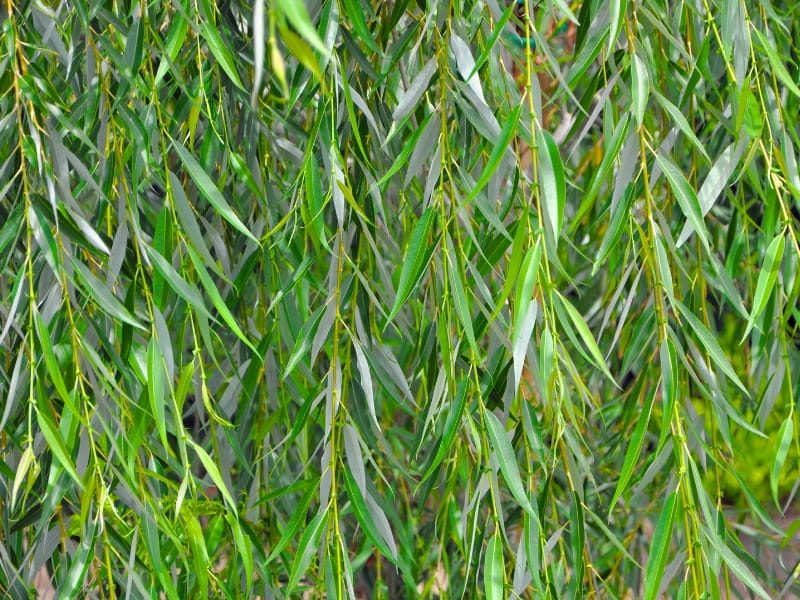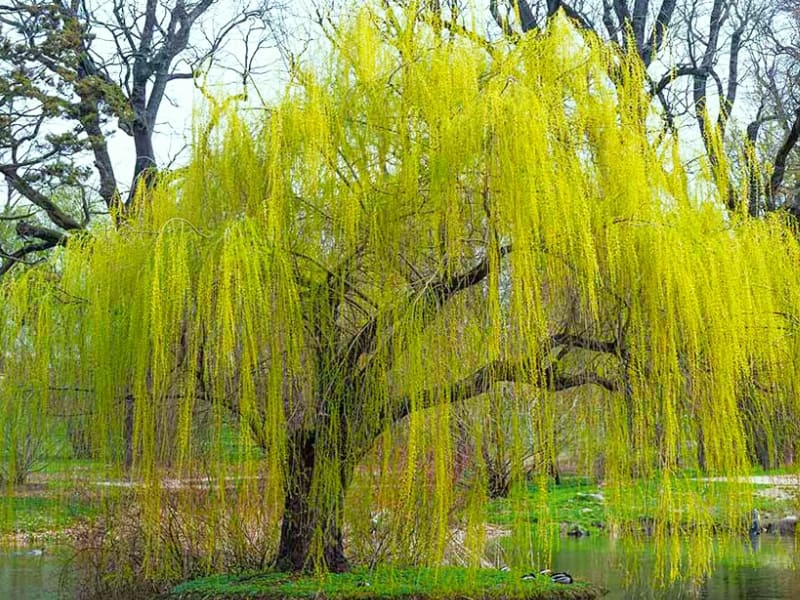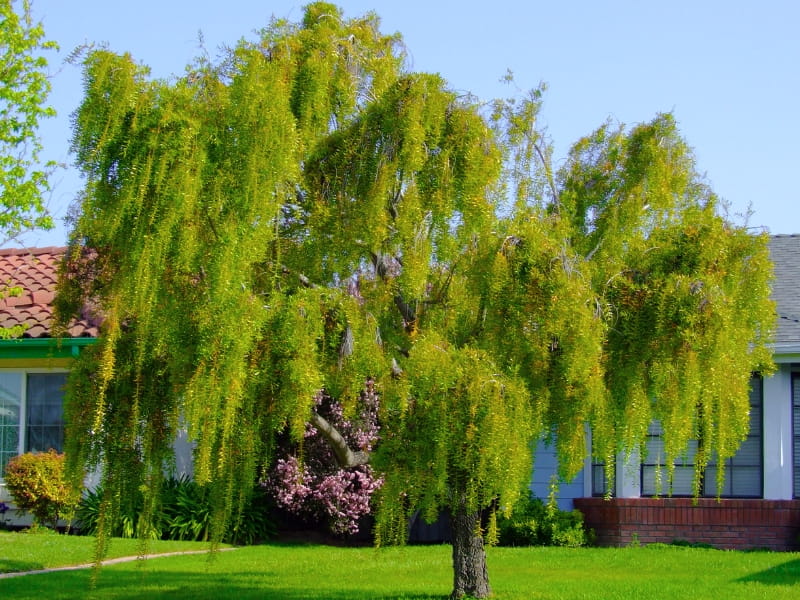Weeping Willow Tree, also known by its common names like Babylon weeping willow, Salix babylonica, and other related Salix species, is a majestic and graceful tree, instantly recognizable for its cascading branches and romantic silhouette. This tree offers more than just visual appeal; it’s steeped in history, symbolism, and even offers some practical benefits.
Gardencenterpoint.com is dedicated to providing comprehensive and helpful guides for all garden lovers. In this detailed guide, you will discover every aspect of Weeping Willow Trees, including how to plant, grow and care for them, as well as exploring its many uses and potential issues and weeping willow tree problems. Keep reading to unlock the secrets of this iconic willow tree.

1. Weeping Willow Tree: An Overview
The Weeping Willow Tree, with its distinctive, ground-sweeping branches, holds a special place in landscapes and cultures around the world. This section provides a foundational understanding of the tree, covering its botanical classification, historical background, and key physical traits.
| Common Names | Weeping Willow, Babylon Weeping Willow, Babylon Willow |
| Botanical Name | Salix babylonica (most common, but other Salix species and hybrids apply) |
| Family | Salicaceae |
| Genus | Salix |
| Species | babylonica, x sepulcralis, alba |
| Origin | Disputed (likely China or the Middle East) |
| Native | Not native to North America, but widely naturalized. |
| Life Cycle | Perennial |
| Plant Type | Deciduous Tree |
| Hardiness Zones | Generally 6-8 (S. babylonica), but varies by variety (e.g., S. alba ‘Tristis’: 2-9, S. x sepulcralis ‘Chrysocoma’: 4-9). |
| Sunlight | Full Sun (at least 6 hours of direct sunlight per day) |
| Maintenance | Moderate to High (due to pruning, potential pest/disease issues) |
| Water | Moderate to High (especially during establishment). Prefers moist soil. |
| Drainage | Well-Drained (essential to prevent root rot) |
| Soil pH | Adaptable, 6.0-8.0 is the optimal range. |
| Spacing | 30-50 feet (minimum) from structures and other trees, considering mature size. |
| Flowering Period | Early Spring (inconspicuous catkins) |
| Height | 30-50 feet (typical), but can reach 70+ feet depending on variety and conditions. |
| Width | 30-50 feet (or wider), matching height. |
| Growth Rate | Fast (3-8 feet per year when young) |
| Flower Color | Yellowish-green (catkins) |
| Leaf Color | Light Green to Grayish-Green |
| Stem Color | Varies by variety (e.g., Golden Weeping Willow has yellow twigs) |
| Bark Color Grayish-brown, deeply furrowed on mature trees. | |
| Flower Benefit | Provides early-season pollen for bees and other pollinators, although not visually significant. |
| Garden Style | Specimen Tree, Water Feature Accent, Privacy Screen (seasonal), Shade Tree |
| Uses | Ornamental, Erosion Control, Phytoremediation, Biomass Production, Basketry (traditionally), Living Structures (see Section 9) |
| Root System Shallow, extensive, and potentially invasive. | |
| Drought tolerance | Medium. |
| Wind Resistance | Can be prone to damage with strong winds. Prune to maintain. |
| Deer Resistance | Low. Deer may browse on young trees. |
| Salt Tolerance | Low to moderate, depending on the species. |
| Pollution tolerance | Moderate to high. |
- Botanical Classification and Common Names
The term “Weeping Willow” most commonly refers to Salix babylonica, although several other Salix species and hybrids exhibit the characteristic weeping growth habit. Here’s a breakdown:- Genus: Salix (This genus includes all willows)
- Species: babylonica (The classic Weeping Willow)
- Hybrids: Many weeping willows are hybrids, such as Salix x sepulcralis (a cross between Salix babylonica and Salix alba)
- Common Names: Weeping Willow, Babylon Willow, Babylon Weeping Willow.
- Historical Significance and Symbolism
The Weeping Willow has a rich history, often associated with mourning, loss, and remembrance. Its origins are somewhat debated, with some believing it originated in China, while others point to the Middle East. Despite its name, Salix babylonica, it is not native to Babylon. The name is thought to be a result of a mistranslation of Biblical texts.
In various cultures, the Weeping Willow has also symbolized:- Resilience: Its flexible branches bend but rarely break, representing the ability to withstand adversity.
- Rebirth and Renewal: Willows readily root from cuttings, symbolizing new life and growth.
- Connection to the Spirit World: In some traditions, the Weeping Willow is seen as a bridge between the living and the dead.
- Physical Characteristics and Growth Habit
Weeping Willows are known for their rapid growth and distinctive appearance:- Growth Rate: They can grow 3-8 feet per year, especially when young.
- Mature Size: Typically reach 30-50 feet in height and width, although some varieties can grow larger.
- Leaves: Narrow, lance-shaped leaves, typically 3-6 inches long, with a light green to grayish-green color.
- Branches: Long, slender, and pendulous, creating the characteristic “weeping” effect.
- Bark: Grayish-brown and deeply furrowed on mature trees.
- Flowers: Inconspicuous catkins (clusters of small flowers) appear in early spring. Willows are dioecious, meaning male and female flowers are on separate trees.
- Root System: Extensive and shallow, often spreading wider than the tree’s crown. This is a crucial consideration for planting location.
- A study by the University of California, Davis, highlighted the rapid growth rate of weeping willows, noting their ability to quickly establish in suitable environments. This rapid growth, while beneficial for quick landscaping, also necessitates careful planning to avoid future issues with infrastructure.
2. Types of Weeping Willow Trees
While Salix babylonica is the iconic Weeping Willow, several other species and cultivars offer variations in size, color, and hardiness. Understanding these differences helps in selecting the best tree for a specific landscape.
- Salix babylonica (Babylon Weeping Willow)
This is the classic Weeping Willow, known for its dramatic weeping form.- Height: 40-50 feet
- Width: 40-50 feet
- Hardiness Zones: 6-8 (can tolerate some Zone 5 locations with protection)
- Distinguishing Features: Strong weeping habit, bright green foliage. Susceptible to several pests and diseases.
- Salix x sepulcralis ‘Chrysocoma’ (Golden Weeping Willow)
A hybrid between Salix babylonica and Salix alba ‘Vitellina’, this cultivar is prized for its golden-yellow twigs, especially vibrant in winter.- Height: 50-70 feet
- Width: 50-70 feet
- Hardiness Zones: 4-9
- Distinguishing Features: Golden-yellow twigs, more disease-resistant than S. babylonica.
- Salix alba ‘Tristis’ (White Weeping Willow)
Another hybrid, often confused with ‘Chrysocoma’, ‘Tristis’ has a more upright form with slightly less pronounced weeping.- Height: 50-70 feet
- Width: 50-70 feet
- Hardiness Zones: 2-9 (very cold-hardy)
- Distinguishing Features: Yellowish-brown twigs, more upright growth habit.
- Other Notable Weeping Willow Varieties
- Salix matsudana ‘Tortuosa’ (Corkscrew Willow): While not a true weeping willow, its twisted branches and upright form create a unique visual interest.
- ‘Prairie Cascade’: A hybrid developed for improved disease resistance and cold hardiness.
- ‘Niobe’: A selection of Salix alba ‘Tristis’ known for its bright yellow stems.
- The Missouri Botanical Garden provides detailed profiles of various willow species and cultivars, offering valuable information for comparing their characteristics and suitability for different climates.
3. Choosing the Right Weeping Willow for Your Landscape
Selecting the right Weeping Willow involves careful consideration of your site conditions, climate, and landscaping goals. This ensures the tree thrives and complements your overall landscape design.
- Assessing Your Site Conditions (Sunlight, Soil, Space)
- Sunlight: Weeping Willows thrive in full sun, requiring at least 6 hours of direct sunlight per day. While they can tolerate partial shade, growth may be less vigorous.
- Soil: They prefer moist, well-drained soil but are adaptable to a wide range of soil types, including clay, loam, and sand. They tolerate acidic to slightly alkaline soils (pH 6.0-8.0).
- Space: This is crucial. Weeping Willows are large trees and need ample space to grow, both above and below ground. Consider the mature size of the specific variety you choose and avoid planting near buildings, power lines, or underground utilities. A minimum distance of 30-50 feet from structures is recommended.
- Climate Considerations and Hardiness Zones
- Hardiness Zones: Refer to the USDA Plant Hardiness Zone Map to determine which zones are suitable for your location. Different willow varieties have different hardiness ranges (see Section 2).
- Temperature Extremes: Consider both summer heat and winter cold. Some varieties are more tolerant of extreme temperatures than others.
- Wind Exposure: While flexible, Weeping Willows can be damaged by strong winds, especially young trees. Choose a sheltered location if possible.
- Determining Your Landscaping Goals (Privacy, Shade, Focal Point)
- Privacy: The dense, weeping branches can provide a visual screen, but consider the tree’s deciduous nature (loses leaves in winter).
- Shade: The broad canopy offers significant shade, reducing cooling costs in summer.
- Focal Point: The Weeping Willow’s unique form makes it an excellent specimen tree, drawing attention and adding drama to the landscape.
- Selecting a Healthy Specimen from a Nursery
- Inspect the Root System: For containerized trees, check for circling roots (roots growing in a circular pattern around the container). These can restrict future growth. For bare-root trees, ensure the roots are moist and not dried out.
- Examine the Branches: Look for healthy, well-spaced branches with no signs of damage, disease, or pest infestation.
- Check the Trunk: Avoid trees with wounds, cracks, or signs of canker.
- Ask Questions: Don’t hesitate to ask the nursery staff about the tree’s origin, care history, and expected growth habit.
- The Arbor Day Foundation offers a tree-buying guide that provides helpful tips for selecting healthy trees from nurseries, ensuring you start with a strong, viable specimen.

4. Planting Your Weeping Willow Tree: A Step-by-Step Guide
Proper planting is essential for the long-term health and success of your Weeping Willow. This section provides a detailed guide to planting, covering site preparation, planting techniques, and initial care.
- Optimal Planting Time and Site Preparation
- Planting Time: The best time to plant a Weeping Willow is in the spring or fall, when the weather is cool and the tree is not actively growing. This allows the roots to establish before the stress of summer heat or winter cold.
- Site Preparation:
- Clear the Area: Remove any grass, weeds, or other vegetation from the planting area. This reduces competition for water and nutrients.
- Test the Soil: Conduct a soil test to determine the pH and nutrient levels. Amend the soil as needed based on the results.
- Improve Drainage: If your soil is heavy clay and drains poorly, consider amending it with organic matter (compost, aged manure) to improve drainage.
- Digging the Planting Hole and Amending the Soil
- Hole Size: Dig a hole that is 2-3 times wider than the root ball or root spread of the tree and just as deep.
- Loosen the Soil: Loosen the soil at the bottom and sides of the hole to encourage root growth.
- Amend the Soil (if necessary): If your soil is poor, mix in some compost or other organic matter with the native soil. Avoid adding fertilizer to the planting hole, as this can burn the roots.
- Proper Planting Techniques for Bare-Root and Containerized Trees
- Bare-Root Trees:
- Soak the roots in water for several hours before planting.
- Spread the roots out in the planting hole.
- Position the tree so that the top of the root flare (where the trunk meets the roots) is slightly above ground level.
- Backfill the hole with the amended soil, gently tamping it down to remove air pockets.
- Containerized Trees:
- Carefully remove the tree from the container.
- Gently loosen any circling roots.
- Place the tree in the hole, ensuring the top of the root ball is level with or slightly above the surrounding ground.
- Backfill the hole with the amended soil, gently tamping it down.
- Bare-Root Trees:
- Staking and Initial Watering
- Staking: Young Weeping Willows often benefit from staking to protect them from wind damage. Use two or three stakes placed outside the root ball and secure the tree with flexible ties. Remove the stakes after one or two growing seasons.
- Initial Watering: Water the newly planted tree deeply and thoroughly. This helps settle the soil and ensures the roots are well-hydrated. Continue to water regularly, especially during dry periods.
- The International Society of Arboriculture (ISA) provides detailed guidelines on tree planting, emphasizing the importance of proper techniques for long-term tree health.
5. Weeping Willow Tree Care: Essential Practices
Ongoing care is crucial for maintaining the health, vigor, and beauty of your Weeping Willow. This section covers essential practices such as watering, fertilizing, pruning, and mulching.
- Watering Requirements and Techniques
- Establishment Period (first 1-2 years): Water deeply and regularly, especially during dry spells. Aim to keep the soil consistently moist but not waterlogged.
- Mature Trees: Once established, Weeping Willows are relatively drought-tolerant but still benefit from supplemental watering during prolonged dry periods.
- Watering Techniques: Deep watering is best, allowing the water to penetrate the root zone. Avoid frequent, shallow watering, which encourages shallow root growth. A soaker hose or drip irrigation system is ideal.
- Fertilizing Schedule and Nutrient Needs
- Young Trees: Avoid fertilizing newly planted trees for the first year. After that, a light application of a balanced fertilizer (e.g., 10-10-10) in early spring can promote growth.
- Mature Trees: Mature Weeping Willows generally do not require heavy fertilization if they are growing in reasonably fertile soil. A soil test can help determine if fertilization is needed.
- Nutrient Needs: Willows benefit from nitrogen, phosphorus, and potassium, as well as micronutrients. A soil test can identify any specific deficiencies.
- Pruning for Health, Shape, and Safety
- Timing: The best time to prune a Weeping Willow is in late winter or early spring, before new growth begins.
- Techniques:
- Remove Dead, Damaged, or Diseased Branches: This is the first priority.
- Thin Out Crowded Branches: This improves air circulation and reduces the risk of disease.
- Prune to Maintain Shape: Remove any branches that are growing in an undesirable direction or interfering with structures.
- Avoid Topping: Topping (cutting back the main branches to stubs) is harmful and should never be done.
- Safety: Use sharp, clean pruning tools to make clean cuts. Be careful when pruning large branches, and consider hiring a certified arborist for major pruning work.
- Mulching and Weed Control
- Mulching: Apply a 2-4 inch layer of organic mulch (wood chips, bark) around the base of the tree, extending out to the drip line (the outer edge of the canopy). Keep the mulch several inches away from the trunk to prevent rot.
- Benefits of Mulching: Mulch helps conserve soil moisture, suppresses weeds, regulates soil temperature, and improves soil health as it decomposes.
- Weed Control: Regularly remove any weeds that grow around the base of the tree.
- The University of Minnesota Extension provides comprehensive information on tree care, including detailed guides on watering, fertilizing, pruning, and mulching, tailored to specific tree species and climates.
6. Common Weeping Willow Problems and Solutions
Weeping Willows, while beautiful, are susceptible to certain pests, diseases, and environmental stressors. This section identifies common problems and provides practical solutions.
- Pests: Aphids, Willow Leaf Beetles, Borers
- Aphids: Small, soft-bodied insects that suck sap from leaves, causing distortion and yellowing.
- Solution: A strong spray of water can dislodge aphids. Insecticidal soap or horticultural oil can also be used. Encourage natural predators like ladybugs.
- Willow Leaf Beetles: Adult beetles and larvae feed on willow leaves, causing skeletonization.
- Solution: Handpick beetles and larvae if possible. Insecticidal soap or neem oil can be effective.
- Borers: Larvae of various beetles and moths that tunnel into the wood, weakening branches and potentially killing the tree.
- Solution: Prune out infested branches. Preventative insecticide treatments may be necessary in areas with high borer pressure. Maintain tree health to reduce susceptibility.
- Aphids: Small, soft-bodied insects that suck sap from leaves, causing distortion and yellowing.
- Diseases: Willow Scab, Crown Gall, Canker
- Willow Scab: A fungal disease that causes leaf spots, defoliation, and twig dieback.
- Solution: Prune out infected branches. Improve air circulation. Fungicide treatments may be necessary in severe cases.
- Crown Gall: A bacterial disease that causes galls (swellings) on roots and stems.
- Solution: There is no cure for crown gall. Remove and destroy infected trees. Avoid planting willows in areas where crown gall has been a problem.
- Canker: Various fungal diseases that cause sunken, discolored areas on branches and trunks.
- Solution: Prune out infected branches, making cuts well below the cankered area. Improve tree health to reduce susceptibility.
- Willow Scab: A fungal disease that causes leaf spots, defoliation, and twig dieback.
- Environmental Stressors: Drought, Wind Damage, Root Rot
- Drought: Prolonged dry periods stress, lead to leaf drop, and increase, in turn, susceptibility to pests and diseases.
- Solution: Provide supplemental water during drought. Deep and less frequently.
- Wind Damage: Strong winds can break branches, especially in young or weakened trees.
- Solution: Plant in a sheltered location. Stake young trees. Prune to remove weak or damaged branches.
- Root Rot: Occurs in poorly drained soils, leading to root decay and tree decline.
- Solution: Improve soil drainage. Avoid overwatering. In severe cases, the tree may need to be removed.
- Drought: Prolonged dry periods stress, lead to leaf drop, and increase, in turn, susceptibility to pests and diseases.
The USDA Forest Service provides extensive research and information on tree pests and diseases, offering detailed identification guides and management strategies.

7. Landscaping with Weeping Willow Trees
Weeping Willows offer a variety of landscaping possibilities, from creating dramatic focal points to providing privacy and shade. This section explores design ideas and companion planting suggestions.
- Creating a Focal Point or Specimen Planting
The Weeping Willow’s unique form and graceful presence make it an ideal specimen tree. Plant it in a prominent location where it can be admired from multiple angles. Consider the background – a dark backdrop (evergreens, a wall) will highlight the weeping branches. - Using Weeping Willows for Privacy Screens
While deciduous, the dense branching structure of Weeping Willows can provide a visual screen, especially during the growing season. Plant multiple trees in a row or staggered pattern for a more effective screen. Consider combining with evergreen shrubs or trees for year-round privacy. - Planting Near Water Features (Ponds, Streams)
Weeping Willows are naturally adapted to moist environments and thrive near water features. Their reflection in the water creates a stunning visual effect. Be mindful of the extensive root system and avoid planting too close to structures or underground pipes. - Companion Planting: What to Grow with Weeping Willows
Choosing companion plants that tolerate the same conditions (moist soil, full sun) is key. Consider these options:- Shrubs: Red Twig Dogwood (Cornus sericea), Winterberry Holly (Ilex verticillata), Buttonbush (Cephalanthus occidentalis)
- Perennials: Astilbe, Ferns, Hostas, Ligularia, Iris
- Groundcovers: Creeping Jenny (Lysimachia nummularia), Ajuga, Vinca minor
- Avoid planting aggressive or invasive species that could compete with the willow’s roots.
The American Horticultural Society offers resources on landscape design, including tips for selecting and combining plants to create harmonious and functional landscapes.
8. Propagating Weeping Willow Trees
Weeping Willows are relatively easy to propagate, allowing you to create new trees from existing ones. This section covers two common methods: cuttings and seeds.
- Growing from Cuttings (Softwood and Hardwood)
- Softwood Cuttings:
- Timing: Take softwood cuttings in late spring or early summer, when new growth is still soft and pliable.
- Selection: Choose healthy, non-flowering shoots, about 4-8 inches long.
- Preparation: Remove the lower leaves and dip the cut end in rooting hormone (optional but recommended).
- Planting: Insert the cuttings into a well-drained potting mix (perlite, vermiculite, peat moss).
- Care: Keep the cuttings moist and humid. A plastic bag or humidity dome can help. Roots should develop within a few weeks.
- Hardwood Cuttings:
- Timing: Take hardwood cuttings in late fall or winter, when the tree is dormant.
- Selection: Choose healthy, one-year-old wood, about 10-12 inches long.
- Preparation: Make a straight cut at the base and a slanted cut at the top. Dip the base in rooting hormone (optional).
- Planting: Insert the cuttings into a well-drained potting mix or directly into the ground. Bury about half the length of the cutting.
- Care: Keep the cuttings moist and protect them from harsh winter conditions. Roots should develop in the spring.
- Softwood Cuttings:
- Seed Propagation (Challenges and Techniques)
While possible, propagating Weeping Willows from seed is less common and more challenging than cuttings.- Challenges: Willow seeds have a short viability period (they lose their ability to germinate quickly). They also require specific conditions for germination.
- Techniques:
- Collect Seeds: Collect seeds from ripe catkins in the spring.
- Sow Immediately: Sow the seeds immediately on the surface of a moist, well-drained seed-starting mix. Do not cover the seeds, as they need light to germinate.
- Keep Moist and Warm: Maintain a consistently moist environment and provide warmth (around 70°F).
- Germination: Germination should occur within a few weeks.
- Transplant: Once the seedlings are large enough to handle, transplant them into individual pots.
9. Weeping Willow Tree: Uses Beyond Aesthetics.
Weeping Willow Trees are valued, not for their beauty, but for their practical applications and versatile properties.
- Traditional uses:
- Basketry: Willow branches, known for flexibility, make crafting baskets, and other woven items, a practice dating back centuries.
- Erosion Control: Willows, with their extensive root systems are effective in stabilizing soil, especially along riverbanks and slopes.
- Medicinal Purposes: The bark of willow trees contains salicin, a compound similar to aspirin. It has been used traditionally to relieve pain and fever.
- Modern Uses:
- Phytoremediation: Weeping willows are used in phytoremediation, a process that utilizes plants to remove pollutants from soil and water. Their roots can absorb heavy metals and other contaminants.
- Biomass Production: Due to their rapid growth, weeping willows are considered a potential source of biomass for renewable energy production.
- Living Fences and Structures: The flexible branches can be woven to create living fences, arbors, and other landscape structures.
A study published in the journal “Environmental Science and Pollution Research” confirmed the effectiveness of weeping willows in removing heavy metals from contaminated soil, highlighting their potential for environmental cleanup.

Leave a Reply